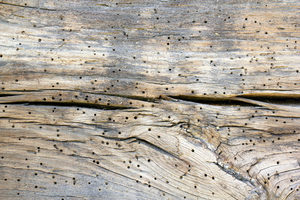At first, the Indian meal moth probably doesn’t seem like that scary a pest, all things considered. It doesn’t look big or dangerous, it’s not destroying your home, and it’s not biting you while you sleep! If that’s how you feel, then consider yourself lucky. If you’re not afraid of Indian meal moths, then you’ve probably never encountered one… in your food.
Food-infesting pests are a special kind of scary. You might accidentally eat them. It’s gross. Indian meal moths are one of the most notorious food-infesting pests in Michigan. Every year, they infest thousands of Michigan cupboards and pantries. You don’t yours to be one of those pantries, trust us. Here’s everything you need to know to make sure it won’t be.
What is an Indian Meal Moth?
Indian meal moths are a common stored food pest insect in Michigan. The name “Indian meal moth” references the fact that it frequently feeds on cornmeal (or “Indian meal”). Adult Indian meal moths are around ⅝ to ¾” long, reddish-brown or copper-colored torsos. Their wingspan is about ½” long. The wings are also copper-colored, but they have a distinctive light tan or grey-colored top section. When Indian meal moths aren’t flying, they fold their wings together along their bodies.
Indian meal moths actually spend a good deal of their lives in their larval or caterpillar form. These larvae are a very light, clear white, yellow, pink, or greenish shade, with a brown head. They start very small and grow consistently longer. Mature larvae grow to around ½ to ⅝” inches long. They often crawl along sheer walls and produce a silk which they spin into cocoons. An Indian meal moth’s entire life cycle completes in about six weeks.

What Do Indian Meal Moths Want?
Contrary to popular belief, adult Indian meal moths lack mouthparts and can’t actually eat anything. Instead, they only live long enough to reproduce and lay their hundreds of eggs. Adult meal moths lay their eggs on (or in) any number of food sources. That way when these offspring hatch, they’ll have food to eat right away. Indian meal moth larvae actually do all the eating–and damage–that you’ll want to watch out for.
Indian meal moth larvae feed on all kinds of stored dry pantry foods. They’ll eat cereal, pasta, bread, sugar, flour, cornmeal, pancake mix, oatmeal, nuts and seeds, cornmeal, and more. Larvae eat constantly until they’ve stored enough energy for adult metamorphosis. Often, they’ll eat their way inside the food they’re feeding on. When they’ve feed enough, larvae spin themselves into cocoons made of a fine silk. Pupation and metamorphosis takes around 30 days. When it’s finished, an adult moth emerges and the cycle begins again.
Where Do Indian Meal Moths Come From?
There are two common ways Indian meal moths infiltrate homes. Either they get in through regular access points, or homeowners inadvertently bring them in themselves. Like all moths, Indian meal moths are attracted to light at night. They may fly toward home lights and, in their confusion, accidentally enter homes through cracks in window and door frames. Moths often enter homes by flying through damaged window screens during the summer time.
More frequently (and upsettingly), however, Indian meal moths get inside your home by stowing away in your food. Meal moth larvae can be very difficult to see, particularly when they’re young. They often eat their way inside the food they inhabit, so they’re not visible from the outside. Many meal moths work their way inside food boxes, as well. Homeowners buy this food and bring it inside. From there, the meal moths can spread to other food sources in their pantries.

How Can I Prevent Indian Meal Moths?
The best way to prevent Indian meal moths is to pay close attention to the food in your pantry. Store all your dry goods in airtight, hard plastic containers. Take cereal out of its cardboard boxes and transfer the bag into hard plastic. Keep pasta boxes inside hard plastic containers. Make sure you fasten the lids of these containers tightly whenever you’re not using them. Clean out your pantry itself frequently, as well, to prevent crumb buildup.
If you’re worried you have pantry moths, take all the food out of your pantry. Thoroughly scrub down the shelves and walls of the pantry. Look for cocoons, silk, or other signs of moths. Then, examine the food itself for silk or signs of damage. Pull apart bread or other foods larvae or eggs could hide in. Throw out all the food that Indian meal moths could have infested. Both at home and when you’re shopping, watch out for food with broken packaging.
If you’re worried you might have an Indian meal moth infestation, don’t panic! Just clear your pantry and give Griffin a call right away. No matter how big or entrenched your infestation may be, we will root it out and eliminate it permanently. Call us, and we’ll make sure you can get back to enjoying your food bug-free.



 You knew
You knew  Pantry-infesting pests like the common
Pantry-infesting pests like the common  Powderpost beetles
Powderpost beetles Yes, unfortunately, the extremely common mice and
Yes, unfortunately, the extremely common mice and